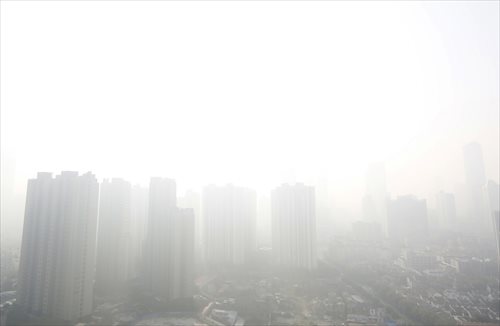

The city is shrouded in a heavy cloud of pollution Thursday. Photo: Cai Xianmin/GT
The quality of the city's air degenerated Thursday evening even after an easterly wind from the sea swept away some of the heavy pollution that settled over the city earlier in the day, according to the Shanghai Environmental Monitoring Center.
Shanghai's Air Quality Index (AQI) hit at 248 at 11 am Thursday, nearing the threshold of 300 for very heavy pollution, the center said. The AQI stood at 259 at 9 pm Thursday.
The Shanghai Municipal Education Commission advised the city's public school administrators Thursday morning to cancel outdoor activities for students, according to the commission's microblog.
Pollution levels began to rise Wednesday afternoon because stable atmospheric conditions allowed pollutants to accumulate in the air, said Zhao Qianbiao, a monitor with the Shanghai Environmental Monitoring Center. The AQI reading was 168 Wednesday, indicating a moderate level of air pollution.
The center advises children and people with heart and respiratory conditions to avoid intensive outdoor activities when the air is moderately polluted. It advises everyone else to cut back on outdoor activities because the heavy pollution can put a strain on their heart and lungs.
When the AQI exceeds 300, the air pollution can make even healthy people susceptible to specific illnesses. The center advises people with heart and respiratory problems, children and the elderly to stay indoors.
Pollution levels continued to rise Thursday morning after a cold front swept in pollutants from northern China, Zhao told the Global Times.
A rise in one of those pollutants, called PM 2.5, was the primary reason why the AQI jumped Thursday.
PM 2.5 stands for particulate matter that is 2.5 micrometers or smaller in diameter. It is especially dangerous because the small size of the particulates allows them to lodge deeply in the lungs, where they can aggravate respiratory illnesses.
The primary sources of PM 2.5 are automobile exhaust, chemical plants and road dust, Zhao said.
The city's PM 2.5 reading rose as high as 240 micrograms per cubic meter around 11 am Thursday. Authorities warn residents to take precautions whenever the reading exceeds 75 micrograms per cubic meter.
The monitoring center predicted Thursday that the level of PM 2.5 would fall below 75 micrograms per cubic meter by Friday morning, but the AQI would remain high, Zhao said.
Copyright ©1999-2018
Chinanews.com. All rights reserved.
Reproduction in whole or in part without permission is prohibited.